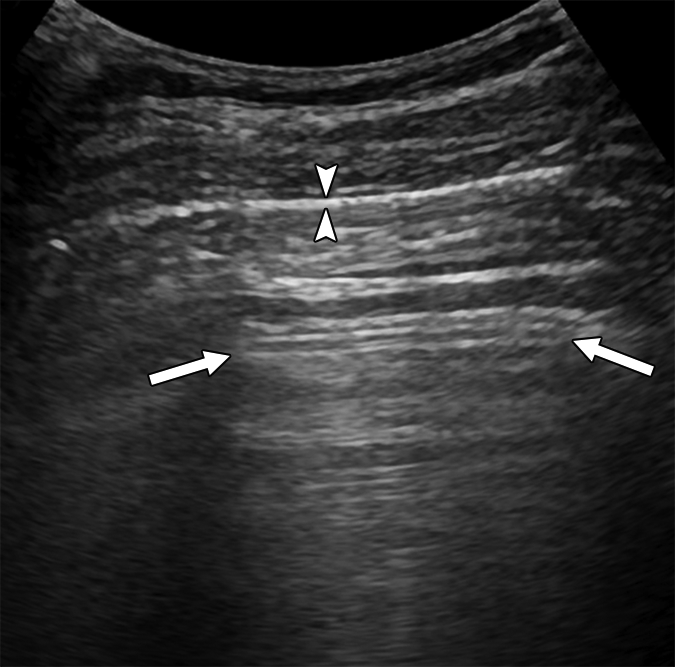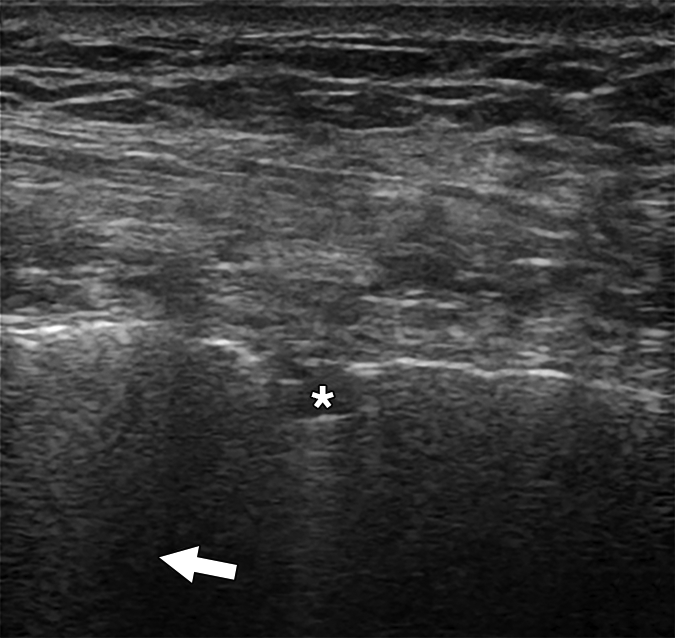- AI
- Molecular Imaging
- CT
- X-Ray
- Ultrasound
- MRI
- Facility Management
- Mammography
Lung Ultrasound Reveals COVID-19 Duration and Disease Severity
Images demonstrate high accuracy for identifying B-lines, thickened pleural lines, and pulmonary consolidation features.
Lung ultrasound can be highly effective for pinpointing B-line, thickened pleural line, and pulmonary consolidation features in patients who test positive for COVID-19, according to new research.
In an article published July 23, in the American Journal of Roentgenology, investigators from Beijing Ditan Hospital in China discussed the efficacy of lung ultrasound in identifying lung abnormalities, as well as the role the modality can play in the management patients with viral infection.
Ultrasound (US) images of 32-year-old healthy male volunteer who was not participant in study. A, Lung US images obtained with convex (A) and linear (B) probes. Both images show thin and smooth surface hyperechoic line, which is called pleural line (between arrowheads), and posterior horizontal echogenic lines, which are called A-lines (arrows). A-lines are differentiated from B-lines by their horizontal but not vertical distribution. Courtesy: American Journal of Roentgenology

“Our results,” said lead study author Yao Zhang, “indicate that lung ultrasound findings can be used to reflect both the infection duration and disease severity.”
To test the performance of these images, Zhang’s team performed lung ultrasound on 28 consecutive patients, between March 3, 2020 and March 30, 2020, who had positive RT-PCR test results for severe acute respiratory SARS-CoV-2. All patients – 14 men and 14 women – had positive findings both on lung ultrasound and chest CT.
82-year-old man who presented with cough, dyspnea, and fever for 10 days. He had close contact with patient who had coronavirus disease (COVID-19), and reverse transcriptase polymerase chain reaction test result was positive for severe acute respiratory syndrome coronavirus 2 (SARS-CoV-2). B, Lung ultrasound images obtained with convex (A) and linear (B) probes. Multiple confluent B-lines (arrows), patchy pulmonary consolidation (asterisk, B), and thickened pleural line (between arrowheads, A) are visualized. Courtesy: American Journal of Roentgenology

According to their analysis of the ultrasound images, Zhang said, all patients had B-lines present, and 19 patients – 67.9 percent – had pulmonary consolidation. In addition, 17 patients – 60.7 percent – had pleural lines. Only one demonstrated a small amount of pleural effusion. The researchers also found that more patients who had longer disease duration experienced thickened pleural line, and those patients with more severe or critical cases had more pulmonary consolidation.
“A thickened pleural line was more frequently observed on ultrasound in patients with longer time intervals after the initial onset of symptoms,” said Zhang’s team.
They noted that the pulmonary consolidations in the more severe cases appeared as tissue-like hypoechoic regions, indicating a significantly reduced air flow and increased quantity of inflammatory cellular exudate.
“Our study shows that pulmonary consolidation depicted on lung ultrasound may serve as an alert in patient management,” Zhang said.
As a repeatable exam in COVID-19-positive patients, lung ultrasound can not only help providers objectively identify which patients have the most severe cases, but it can also ensure continued disease monitoring. This capability can be particularly valuable, Zhang said, in cases where chest CT is not available, such as in intensive care units or isolation wards.
Based on these findings, Zhang’s team said, severity score for lung ultrasound, similar to what exists for CT scans, should be developed to enable more accurate comparisons in future research endeavors.
Leading Breast Radiologists Discuss the USPSTF Breast Cancer Screening Recommendations
May 17th 2024In recognition of National Women’s Health Week, Dana Bonaminio, MD, Amy Patel, MD, and Stacy Smith-Foley, MD, shared their thoughts and perspectives on the recently updated breast cancer screening recommendations from the United States Preventive Services Task Force (USPSTF).
The Reading Room: Racial and Ethnic Minorities, Cancer Screenings, and COVID-19
November 3rd 2020In this podcast episode, Dr. Shalom Kalnicki, from Montefiore and Albert Einstein College of Medicine, discusses the disparities minority patients face with cancer screenings and what can be done to increase access during the pandemic.
Multicenter CT Study Shows Benefits of Emerging Diagnostic Model for Clear Cell Renal Cell Carcinoma
May 15th 2024Combining clinical and CT features, adjunctive use of a classification and regression tree (CART) diagnostic model demonstrated AUCs for detecting clear cell renal cell carcinoma (ccRCC) that were 15 to 22 percent higher than unassisted radiologist assessments.
CT Study: AI Algorithm Comparable to Radiologists in Differentiating Small Renal Masses
May 14th 2024An emerging deep learning algorithm had a lower AUC and sensitivity than urological radiologists for differentiating between small renal masses on computed tomography (CT) scans but had a 21 percent higher sensitivity rate than non-urological radiologists, according to new research.
